A Systematic Review on the Implementation of Agility in Sustainable Design Development
Abstract
:1. Introduction
2. Background of Study
2.1. The Development of Sustainable Design
2.2. Agility
2.3. Integrated Sustainable Design Method with Agility
3. Method
4. Result and Discussion
4.1. Descriptive Analysis of Selected Literature
4.2. Descriptive Analysis of Sustainable Design Method with Agility
4.3. Sustainable Design Integrated Agility Concept
- (a)
- Sustainable Supply Chain: Creating a sustainable supply chain involves implementing ethical and environmentally responsible practices. The focus of sustainable design is to ensure that the supply chain is sustainable. Key topics include selecting, managing, and maintaining stakeholders. In today’s unpredictable market, designing a sustainable supply chain involves developing resilience and flexibility in businesses while also using life cycle assessment techniques to achieve agility in the process.
- (b)
- Software Engineering: Research on sustainable design in the field of Software Engineering has a specific focus on agility. This involves improving iteration, communication, collaboration, process simplification, design simplicity, and flexibility during the development process. The literature emphasizes the significance of lifecycle analysis in implementing agility, as well as the importance of coherent, self-organizing agile teams that facilitate collaboration.
- (c)
- Production: The production field has the highest number of papers. When studying sustainable agility methods, it is important to focus on the integration of organizational structure and individual management processes in production. To implement an agile, sustainable approach in the production field, it is crucial to have a clear understanding of the company’s situation as well as the market and competition. Enterprises need to be able to quickly gather and understand information, set clear goals, and create flexible plans based on forecasts. Studies have shown that agility is important in the selection of solutions for sustainable design. Identifying relevant risks and opportunities is also crucial in the practice of agile sustainable methods. Moreover, organizations must have the ability to learn and accumulate lessons to successfully implement an agile, sustainable approach.
- (d)
- Digital Supply Chain: The digital supply chain involves using digital technology and data analysis to make informed decisions, improve performance, and respond quickly to changes in the supply chain. To achieve an agile and sustainable approach, both organizational management and technical aspects must be considered. Organizational management can benefit from open and dynamic systems, self-organizing and self-learning capabilities, adaptive capabilities, visibility, monitoring and feedback control, collaborative capabilities, circular economy and industrial symbiosis, and data-driven analysis and modelling. Technology can provide advantages such as real-time inventory control, custom assembly and modular production, flexible capacity sharing, risk mitigation inventory, alternate shipping routes, multiple procurement risks, closed-loop supply chains, collaborative robotics, additive manufacturing, and augmented and virtual reality.
- (e)
- Digital Factory: A digital factory is a technological system that allows companies to share digital information seamlessly throughout their entire operational process. Research in the field of digital factories highlights the crucial role of IT in industrial production. Among the important sustainable design methods of digital factories with agility characteristics are data modelling, data analysis, and the Internet of Things. Parallel design and additive technology serve as the main solutions within this field.
- (f)
- Performance Driven: The performance-driven field focused on agility sustainable design aims to enhance the overall performance of the enterprise. The agility sustainable design method covers sustainable product-service systems, product and service diversity, management, technology, product and service innovation, collaborative innovation, business collaboration, information sharing, and enterprise learning.
- (g)
- Intelligent organization: Organizations that prioritize free and open information exchange are viewed as intelligent models. The concept of intelligent organization has gained attention as a research field in recent years, primarily focused on the challenges businesses will face in the Industry 4.0 era. Studies have predicted that this new industrial ecology will offer enterprises opportunities to embrace smart technologies, which in turn will provide agility and flexibility. Sustainable design will also expand and encompass various areas of social development, including user experience design, cloud-based computer-supported collaborative work, social product development, smart innovation and business value chain design, collaboration for product realization crowdsourcing, open architecture product and service platform design, human-centered cyber-physical work system design, networked manufacturing system design, cyber-physical production system design, recycling, machine learning and artificial intelligence for data-informed design, dynamic risk management for cyber-physical socio-technical systems, cybersecurity, and verification and validation for design research.
4.4. Implication of Agility in Sustainable Design
- (a)
- Highly Autonomous Organization. Enterprises are facing an increasingly complex living environment and a consumer-centered market. As a result, they need to adopt new management models to achieve higher levels of customization and deeper customer relationships. An organization’s cognitive ability can enhance its capacity to process information and deal with uncertainty. This cognitive ability can also impact an enterprise’s autonomy and its ability to take flexible and agile action. SMEs are representative of highly autonomous organizations that achieve a competitive position by coexisting with large enterprises through informal strategies and flexible structures [109]. Entrepreneurial thinking plays a significant role in highly autonomous organizations, promoting high-speed innovation and ensuring that SMEs improve their performance in fierce competition [110].
- (b)
- Establish an Organizational Learning Model. In today’s globalized business world, companies must work to bridge cultural gaps within their supply chain. This involves establishing a continuous learning model and promoting mutual learning between organizations [83]. When unexpected challenges arise, it is crucial for companies to build resilience through experimentation, absorption, and innovation. Managers must also engage in democratic dialogue with employees across different cultures and borders rather than relying on traditional top-down strategies. Continuous learning is key to improving team efficiency and driving innovation and can help employees realize their full potential [49]. By fostering a shared language and culture, organizations can build trust and collaboration among team members, ultimately leading to greater success [53].
- (c)
- Establishing an Agile Mode of Organizational Collaboration. When organizations collaborate, they can complement each other’s resources and achieve diversity. Coordination is easier when partners share the same sustainability and agility requirements, allowing them to take systematic actions and mobilize resources. This collaboration can also lead to coordinated innovation for enterprises [111]. In today’s professional supply chain process, internal multi-disciplinary organizations need to communicate and balance effectively. Collaboration should not only occur between parallel organizations but also between organizations with parallel production based on organizational learning. Collaboration capabilities are essential for supply chain integration. To meet customer demands, supply chain efficiency and performance rely on organizational knowledge, information exchange, employee capabilities, and business processes. Agile collaboration in organizations seeks simplified procedures and seamless connections. In [72], authors suggest that organizations can resist environmental interference by generating new knowledge through collaboration. High-frequency collaboration brings energy to organizations and allows them to respond flexibly to changing environments [72].
- (d)
- Management and Decision-making are Agile-oriented. To create an organization that operates with agility, its managers must be highly attuned to both internal and external changes. They must also establish a system that enables timely and effective communication across different fields, offer genuine commitment and support to their team, establish common goals, and enhance the team’s capacity to act quickly. When faced with uncertainty and high-risk situations, the organization must be able to quickly reassign resources. This is why adopting an agile management approach is essential for promoting internal coordination and external cooperation within the organization, as well as for facilitating knowledge sharing and flow. Through implicit management methods, organizational managers reduce central control and provide participants with the space they need to utilize their tacit knowledge [53]. Agile decision-making involves leaders being able to accurately identify and refine key information, react swiftly, and utilize available resources and information. This depends on the knowledge base and experience of the entire team. Therefore, the primary objective of agile management is to foster trust among project participants and ensure that knowledge flows freely within the team.
- (e)
- Combining Lean and Flexible Paradigms. Eliminating non-value-added activities and improving efficiency are crucial strategies for SMEs to achieve sustainable development. Through the implementation of lean and flexible paradigms, businesses can reduce waste, inventory, and rework while increasing output, flexibility, and delivery time. Additionally, these strategies improve the ability to solve problems, standardize work, and advance processes. A flexible labor force and maintaining production stability are also essential components of lean thinking [112]. To successfully implement lean and flexible paradigms, collaboration among enterprises and updated knowledge is necessary. Streamlined institutional processes and organizational management strategies are driving factors for success. When combined with the triple bottom line theory, a lean and flexible paradigm can make positive contributions to sustainable strategies [113]. The application of information processing technology and network communication is also vital for the success of these paradigms. Developing a strategic awareness of continuous renewal and transformation is necessary for organizations to form an agile, sustainable paradigm. Making decisions that benefit future development according to the current situation and maintaining excellent operation and vigorous development are also essential.
- (f)
- Application of Digital Technology. Incorporating digital tools and technologies is known as digitalization, which can enhance the business processes of enterprises by making them more efficient. This, in turn, provides a foundation for the implementation of agility and sustainability. By utilizing digital technology, enterprises can obtain diversified information, and the analysis function of big data can provide predictions for enterprise decisions [114]. Search technology can help enterprises interpret subtle signals after communicating with partners and take targeted actions. AI can assist in management by providing a system that simplifies thinking and procedures [115]. Furthermore, digital technology can detect organizational activities and improve the quality of work. Digital technology has made it easier for all stakeholders in the value chain to connect. Remote collaboration, virtual processes, and real-time connections have brought unprecedented efficiency and convenience to enterprises [116]. Digital technology has also shown the advantages of high efficiency and energy conservation in product lifecycle management, which is essential for enterprise sustainability [117]. The Internet of Things system, machine learning system, process optimization technology, quality improvement technology, talent-increasing manufacturing system, and flexible manufacturing system are all key driving factors of the sustainable development of enterprise agility derived from digital technology.
- (g)
- Adopt the Modularization Strategy. Modularization involves breaking down system components into units that are closely connected while avoiding accidental interaction with other modules [118,119]. This design and management strategy in complex systems allows for the separation or recombination of modules without changing other components, maximizing flexibility and agility. In the supply chain, modularization emphasizes outsourcing of key technologies by module suppliers who must be flexible and agile in dealing with customers [120]. This improves the overall competitive strength of the supply chain and promotes differentiation of enterprise competitiveness, benefiting resource allocation. Modular design in the production process improves the universality and standardization of components, facilitating modification, combination, and product customization for production agility. In product service systems, modular strategies cope with changing customer needs by dividing and reconfiguring components to optimize service performance, cost, and response time [64]. However, applying modular concepts requires information sharing, organizational collaboration, and digital technology to master data, maintain close communication with partners, respond quickly to changes, and reconfigure resources for a competitive advantage.
- (h)
- Adopt a Reconfigurable System. The idea of a reconfigurable system is widely used in the manufacturing industry. It involves modularization, which allows companies to quickly remove, adjust, add, or change the component structure to adapt to production needs. This helps businesses cope with changes in market demand and reduces time and cost. By using appropriate modularization and system reconfiguration, a company can form other product families after completing a series of products. This strengthens the enterprise’s ability to respond to changes by forming component and product families [78]. The concept of reconfigurable systems is also applied in enterprise and supply chain systems to deal with and adapt to changes in complex structures. Whether in production or enterprise and supply chain systems, reconfiguration depends on the application capability of digital technology [121].
5. Conclusions
- (a)
- In today’s business world, research on agility is becoming increasingly important. This study covers a wide range of agility-related topics and has found that 66% of research on management agility focuses on the production stage of a product. With the emergence of new technologies, sustainable design and agility practices can go beyond what is currently found in peer-reviewed literature. Future research could focus on the agility of specific product research and development, which may require more meetings, seminars, technical documents, or business reports to narrow the existing gap. Additionally, enterprise agility is reflected in every step of the supply chain, making it interesting to study the production and management links in the supply chain and the stakeholders’ changing perception of agility.
- (b)
- At present, only 10 percent of research has considered the incorporation of agility in all aspects of production organizations. In the future, researchers should focus on the role of agility in sustainable R&D cooperation among enterprises. This will benefit society as a whole and make it easier to achieve sustainable development. Achieving sustainability is a complex process that requires the joint efforts of various organizations, enterprises, supply chains, science and technology, processes, stakeholders, and consumers. Evaluating the strength of sustainable design capability reveals the innovation capacity of enterprises and highlights the level of sustainable development of the supply chain and society. Therefore, it is essential to further understand the impact of agility on sustainable design.
Author Contributions
Funding
Data Availability Statement
Acknowledgments
Conflicts of Interest
References
- Le, T.T.; Tran, P.Q.; Lam, N.P.; Tra, M.N.L.; Uyen, P.H.P. Corporate social responsibility, green innovation, environment strategy and corporate sustainable development. Oper. Manag. Res. 2023, 2023, 1–21. [Google Scholar] [CrossRef]
- Manda, B.M.K.; Bosch, H.; Karanam, S.; Beers, H.; Bosman, H.; Rietveld, E.; Worrell, E.; Patel, M.K. Value creation with life cycle assessment: An approach to contextualize the application of life cycle assessment in chemical companies to create sustainable value. J. Clean. Prod. 2016, 126, 337–351. [Google Scholar] [CrossRef]
- He, F.; Miao, X.; Wong, C.W.Y.; Lee, S. Contemporary corporate eco-innovation research: A systematic review. J. Clean. Prod. 2018, 174, 502–526. [Google Scholar] [CrossRef]
- Palomares-Aguirre, I.B.S.; Barnett, M.; Layrisse, F. Built to scale? How sustainable business models can better serve the base of the pyramid. J. Clean. Prod. 2018, 172, 4506–4513. [Google Scholar] [CrossRef]
- Agarwal, V.; Hameed, A.Z.; Malhotra, S.; Mathiyazhagan, K.; Alathur, S.; Appolloni, A. Role of Industry 4.0 in agile manufacturing to achieve sustainable development. Bus. Strategy Environ. 2022. online version. [Google Scholar] [CrossRef]
- Hariyani, D.; Mishra, S. Structural equation modeling of drivers for the adoption of an integrated sustainable-green-lean-six sigma-agile manufacturing system (ISGLSAMS) in Indian manufacturing organizations. Clean. Circ. Bioecon. 2023, 4, 100037. [Google Scholar] [CrossRef]
- Kombaya Touckia, J.; Hamani, N.; Kermad, L. Digital twin framework for reconfigurable manufacturing systems (RMSs): Design and simulation. Int. J. Adv. Manuf. Technol. 2022, 120, 5431–5450. [Google Scholar] [CrossRef] [PubMed]
- Almoslehy, S.A.M.; Alkahtani, M.S. Key approaches, risks, and product performance in managing the development process of complex products sustainably. Sustainability 2021, 13, 4727. [Google Scholar] [CrossRef]
- Wan, G.; Dong, X.; Dong, Q.; He, Y.; Zeng, P. Design and implementation of agent-based robotic system for agile manufacturing: A case study of ARIAC 2021. Robot. Comput.-Integr. Manuf. 2022, 77, 102349. [Google Scholar] [CrossRef]
- Joshi, M.P. Strategic agility: Linking strategic framework to agile framework. In Senior Leadership Teams and the Agile Organization; Routledge: London, UK, 2023; pp. 82–102. [Google Scholar]
- Chow, T.; Cao, D. A survey study of critical success factors in agile software projects. J. Syst. Softw. 2008, 81, 961–971. [Google Scholar] [CrossRef]
- Leite, M.; Braz, V. Agile manufacturing practices for new product development: Industrial case studies. J. Manuf. Technol. Manag. 2016, 27, 560–576. [Google Scholar] [CrossRef]
- Altunel, H. Agile Project Management in Product Life Cycle. Int. J. Inf. Technol. Proj. Manag. 2017, 8, 50–63. [Google Scholar] [CrossRef]
- Aoyama, M. Web-Based Agile Software Development. IEEE Softw. 1998, 15, 56–65. [Google Scholar] [CrossRef]
- Daneva, M.; Van Der Veen, E.; Amrit, C.; Ghaisas, S.; Sikkel, K.; Kumar, R.; Ajmeri, N.; Ramteerthkar, U.; Wieringa, R. The Journal of Systems and Software Agile requirements prioritization in large-scale outsourced system projects: An empirical study. J. Syst. Softw. 2013, 86, 1333–1353. [Google Scholar] [CrossRef]
- Haeruddin, M.I.W.; Musa, M.I.; Kurniawan, A.W. Marketing Strategy Analysis in A Global Market. J. Manag. Econ. Rev. 2023, 1, 17–24. [Google Scholar]
- Zhao, Y.; Peng, B.; Iqbal, K.; Wan, A. Does market orientation promote enterprise digital innovation? Based on the survey data of China’s digital core industries. Ind. Mark. Manag. 2023, 109, 135–145. [Google Scholar] [CrossRef]
- Ross, D.A.; Engineering, M.; Design, P.S.; Knowledge, E.; Phase, C.D. Exploring the effectiveness of providing structured design-for-the-environment strategies during conceptual design. J. Mech. Des. 2022, 144, 032001. [Google Scholar] [CrossRef]
- Keitsch, M. Sustainable Design: A Brief Appraisal of its Main Concepts. Sustain. Dev. 2012, 20, 180–188. [Google Scholar] [CrossRef]
- Rashid, N.; Khan, S.U. Using agile methods for the development of green and sustainable software: Success factors for GSD vendors. J. Softw. Evol. Process 2018, 30, e1927. [Google Scholar] [CrossRef]
- Udokporo, C.K.; Anosike, A.; Lim, M.; Nadeem, S.P.; Garza-Reyes, J.A.; Ogbuka, C.P. Impact of Lean, Agile and Green (LAG) on business competitiveness: An empirical study of fast moving consumer goods businesses. Resour. Conserv. Recycl. 2020, 156, 104714. [Google Scholar] [CrossRef]
- Galán, O.A.A.; Valdéz, J.L.C.; Medina, H.F.; Contreras, G.A.V.; Sumuano, J.L.S. Proposal of a sustainable agile model for software development. Int. J. Adv. Comput. Sci. Appl. 2020, 11, 42–49. [Google Scholar] [CrossRef]
- Endres, M.; Bican, P.M.; Wöllner, T. Sustainability meets agile: Using Scrum to develop frugal innovations. J. Clean. Prod. 2022, 347, 130871. [Google Scholar] [CrossRef]
- Wang, C.N.; Yang, C.Y.; Cheng, H.C. A Fuzzy Multicriteria Decision-Making (MCDM) Model for Sustainable Supplier Evaluation and Selection Based on Triple Bottom Line Approaches in the Garment Industry. Processes 2019, 7, 400. [Google Scholar] [CrossRef]
- Andersen, M.M. On the faces and phases of eco-innovation on the dynamics of the greening of the economy. In Proceedings of the Druid Summer Conference 2010, London, UK, 16–18 June 2010. [Google Scholar]
- Crespi, F.; Mazzanti, M.; Managi, S. Green growth, eco-innovation and sustainable transitions. Environ. Econom. Policy Stud. 2016, 18, 137–141. [Google Scholar] [CrossRef]
- De Jesus, A.; Antunes, P.; Santos, R.; Mendonça, S. Eco-innovation in the transition to a circular economy: An analytical literature review. J. Clean. Prod. 2016, 172, 2999–3018. [Google Scholar] [CrossRef]
- Mazzanti, M. Eco-innovation and sustainability: Dynamic trends, geography and policies. J. Environ. Plan. Manag. 2018, 61, 1851–1860. [Google Scholar] [CrossRef]
- Hazarika, N.; Zhang, X. Evolving theories of eco-innovation: A systematic review. Sustain. Prod. Consum. 2019, 19, 64–78. [Google Scholar] [CrossRef]
- Kanda, W.; del Río, P.; Hjelm, O.; Bienkowska, D. A technological innovation systems approach to analyse the roles of intermediaries in eco-innovation. J. Clean. Prod. 2019, 227, 1136–1148. [Google Scholar] [CrossRef]
- Mouzakitis, Y.; Adamides, E.D. The bottom-up side of eco-innovation: Mapping the dynamics of sustainable grassroots innovations. In Smart Innovation, Systems and Technologies; Springer: Singapore, 2019; Volume 155. [Google Scholar] [CrossRef]
- Kim, S.; Moon, S.K. Sustainable platform identification for product family design. J. Clean. Prod. 2017, 143, 567–581. [Google Scholar] [CrossRef]
- Melles, G.D.; de Vere, I.; Misic, V. Socially responsible design: Thinking beyond the triple bottom line to socially responsive and sustainable product design. CoDesign 2011, 7, 143–154. [Google Scholar] [CrossRef]
- Sanders, E.B.; Stappers, P.J.; Sanders, E.B.; Co-creation, P.J.S. Co-creation and the new landscapes of design. Co-Design 2008, 4, 5–18. [Google Scholar] [CrossRef]
- Morelli, N. Social Innovation and New Industrial Contexts: Can Designers “Industrialize” Socially Responsible Solutions? Design Issues 2007, 23, 3–21. [Google Scholar] [CrossRef]
- Brown, B.T.; Wyatt, J. Design Thinking for Social Innovation. Stanf. Soc. Inn. Rev. 2010, 12, 29–43. [Google Scholar] [CrossRef]
- Holt, R.; Barnes, C. Towards an integrated approach to “ Design for X”: An agenda for decision-based DFX research. Res. Eng. Des. 2010, 21, 123–136. [Google Scholar] [CrossRef]
- Gagnon, B.; Leduc, R.; Savard, L. From a conventional to a sustainable engineering design process: Different shades of sustainability. J. Eng. Des. 2012, 23, 49–74. [Google Scholar] [CrossRef]
- Hao, Y.P.; Helo, P.; Shamsuzzoha, A. Virtual factory system design and implementation: Integrated sustainable manufacturing. Int. J. Syst. Sci. Oper. Logistics. 2018, 5, 116–132. [Google Scholar] [CrossRef]
- Younesi, M.; Roghanian, E. A framework for sustainable product design: A hybrid fuzzy approach based on Quality Function Deployment for Environment. J. Clean. Prod. 2015, 108, 385–394. [Google Scholar] [CrossRef]
- Buchert, T.; Halstenberg, F.A.; Bonvoisin, J.; Lindow, K.; Stark, R. Target-driven selection and scheduling of methods for sustainable product development. J. Clean. Prod. 2017, 161, 403–421. [Google Scholar] [CrossRef]
- Francia, D.; Caligiana, G.; Liverani, A.; Frizziero, L.; Donnici, G. PrinterCAD: A QFD and TRIZ integrated design solution for large size open moulding manufacturing. Int. J. Interact. Des. Manuf. 2018, 12, 81–94. [Google Scholar] [CrossRef]
- Guo, X.; Zhao, W.; Hu, H.; Li, L.; Liu, Y.; Wang, J.; Zhang, K. A smart knowledge deployment method for the conceptual design of low-carbon products. J. Clean. Prod. 2021, 321, 128994. [Google Scholar] [CrossRef]
- Wilding, R.D. Short-term strategic management in mass customized markets. Logist. Inf. Manag. 1997, 10, 199–207. [Google Scholar]
- Maskell, B. Insight from industry The age of agile manufacturing. Supply Chain. Manag. Int. J. 2001, 6, 5–11. [Google Scholar] [CrossRef]
- Jin-Hai, L.; Anderson, A.R.; Harrison, R.T. The evolution of agile manufacturing. Bus. Process Manag. J. 2003, 9, 170–189. [Google Scholar] [CrossRef]
- Gunasekaran, A.; Lai, K.; Cheng, T.C.E. Responsive supply chain: A competitive strategy in a networked economy. J. Omega 2008, 36, 549–564. [Google Scholar] [CrossRef]
- Geyi, D.G.; Yusuf, Y.; Menhat, M.S.; Abubakar, T.; Ogbuke, N.J. Agile capabilities as necessary conditions for maximising sustainable supply chain performance: An empirical investigation. Int. J. Prod. Econ. 2020, 222, 107501. [Google Scholar] [CrossRef]
- Holbeche, L.S. Organisational effectiveness and agility. J. Organ. Eff. 2018, 5, 302–313. [Google Scholar] [CrossRef]
- Nejatian, M.; Zarei, M.H.; Rajabzadeh, A.; Azar, A.; Khadivar, A. Paving the path toward strategic agility: A methodological perspective and an empirical investigation. J. Enterp. Inf. Manag. 2019, 32, 538–562. [Google Scholar] [CrossRef]
- Mengoni, M.; Germani, M.; Mandorli, F. A structured agile design approach to support customisation in wellness product development. Int. J. Comput. Integr. Manuf. 2009, 22, 42–54. [Google Scholar] [CrossRef]
- Khatri, A.; Garg, D.; Dangayach, G.S. An empirical investigation of agility factors in select Indian manufacturing industries. Int. J. Bus. Inf. Syst. 2018, 28, 42–66. [Google Scholar] [CrossRef]
- Nold, H.; Michel, L. The performance triangle: A model for corporate agility. Leadersh. Organ. Dev. J. 2016, 37, 341–356. [Google Scholar] [CrossRef]
- Arbussa, A.; Bikfalvi, A.; Marquès, P. Strategic agility-driven business model renewal: The case of an SME. Manag. Dec. 2017, 55, 271–293. [Google Scholar] [CrossRef]
- Yang, G.; Zhang, X. Construction of computer-aided industrial design system based on agility. Int. J. Comput. Sci. Math. 2015, 6, 492–500. [Google Scholar] [CrossRef]
- Gunasekaran, A.; Yusuf, Y.Y. International Journal of Agile manufacturing: A taxonomy of strategic and technological imperatives. Int. J. Prod. Res. 2010, 2013, 37–41. [Google Scholar] [CrossRef]
- Sarkis, J.; Talluri, S.; Gunasekaran, A. A strategic model for agile virtual enterprise partner selection. Int. J. Oper. Prod. Manag. 2007, 27, 1213–1234. [Google Scholar] [CrossRef]
- Mondragon, A.E.C.; Lyons, A.C.; Kehoe, D.F. Assessing the value of information systems in supporting agility in high-tech manufacturing enterprises. Int. J. Oper. Prod. Manag. 2004, 24, 1219–1246. [Google Scholar] [CrossRef]
- Lin, B. International Journal of Production Original equipment manufacturers (OEM) manufacturing strategy for network innovation agility: The case of Taiwanese manufacturing networks. Int. J. Prod. Res. 2004, 42, 943–957. [Google Scholar] [CrossRef]
- Go, T.F.; Wahab, D.A.; Hishamuddin, H. Multiple generation life-cycles for product sustainability: The way forward. J. Clean. Prod. 2015, 95, 16–29. [Google Scholar] [CrossRef]
- Chiu, M.; Chu, C. Review of Sustainable Product Design from Life Cycle Perspectives. Int. J. Precis. Eng. Manuf. 2012, 13, 1259–1272. [Google Scholar] [CrossRef]
- Ostergaard, K.J.; Summers, J.D. Development of a systematic classification and taxonomy of collaborative design activities. J. Eng. Des. 2009, 20, 57–81. [Google Scholar] [CrossRef]
- Misceo, M.; Buonamici, R.; Buttol, P.; Naldesi, L.; Grimaldi, F.; Rinaldi, C. TESPI (Tool for Environmental Sound Product Innovation): A simplified software tool to support environmentally conscious design in SMEs. Environ. Conscious Manuf. IV 2004, 5583, 186–192. [Google Scholar] [CrossRef]
- Song, W.; Sakao, T. A customization-oriented framework for design of sustainable product/service system. J. Clean. Prod. 2017, 140, 1672–1685. [Google Scholar] [CrossRef]
- Dunmade, I. Design for Multipurpose Use: An application of DfE concept in a developing economy. Environ. Cons. Manuf. IV 2004, 5583, 193–199. [Google Scholar] [CrossRef]
- Dunmade, I.; Rosentrater, K. Designing for multi-lifecycle to promote industrial ecology philosophy. Environ. Cons. Manuf. VI 2006, 6385, 178–184. [Google Scholar] [CrossRef]
- Gu, P.; Xue, D.; Nee, A.Y.C. Adaptable design: Concepts, methods, and applications. Proc. IMechE 2009, 223, 1367–1387. [Google Scholar] [CrossRef]
- Nielsen, K.; Brunoe, T.D.; Nielsen, K.; Ditlev, T.; Cradle, B.; Supply, C.L. Cradle to Cradle Products, Modularity and Closed Loop Supply Chains; Springer: Berlin/Heidelberg, Germany, 2016. [Google Scholar]
- Perera, S.; Soosay, C.; Sandhu, S. Investigating the strategies for supply chain agility and competitiveness. Asian J. Bus. Account. 2019, 12, 279–312. [Google Scholar] [CrossRef]
- El-Khalil, R.; Mezher, M.A. The mediating impact of sustainability on the relationship between agility and operational performance. Oper. Res. Perspect. 2020, 7, 100171. [Google Scholar] [CrossRef]
- Singh, A.K.; Vinodh, S. Modeling and performance evaluation of agility coupled with sustainability for business planning. J. Manag. Dev. 2017, 36, 109–128. [Google Scholar] [CrossRef]
- Chiang, C.T.; Kou, T.C.; Koo, T.L. A systematic literature review of the it-based supply chain management system: Towards a sustainable supply chain management model. Sustainability 2021, 13, 2547. [Google Scholar] [CrossRef]
- Briner, R.B.; Mary, Q.; Denyer, D. Systematic Review and Evidence Synthesis as a Practice and Scholarship Tool. In The Oxford Handbook of Evidence-Based Management; Oxford Library of Psychology: Oxford, UK, 2012; pp. 112–129. [Google Scholar] [CrossRef]
- Sharma, V.; Raut, R.D.; Mangla, S.K.; Narkhede, B.E.; Luthra, S.; Gokhale, R. A systematic literature review to integrate lean, agile, resilient, green and sustainable paradigms in the supply chain management. Bus. Strategy Environ. 2021, 30, 1191–1212. [Google Scholar] [CrossRef]
- Counsell, C.; Do, W.; Come, Q. Formulating Questions and Locating Primary Studies for Inclusion in Systematic Reviews. Ann. Int. Med. 1997, 127, 380–387. [Google Scholar] [CrossRef]
- Xavier, A.F.; Naveiro, R.M.; Aoussat, A.; Reyes, T. Systematic literature review of eco-innovation models: Opportunities and recommendations for future research. J. Clean. Prod. 2017, 149, 1278–1302. [Google Scholar] [CrossRef]
- Dekkers, S.; Wijnhoven, S.W.P.; Braakhuis, H.M.; Soeteman-Hernandez, L.G.; Sips, A.J.A.M.; Tavernaro, I.; Kraegeloh, A.; Noorlander, C.W. Safe-by-Design part I: Proposal for nanospecific human health safety aspects needed along the innovation process. NanoImpact 2020, 18, 100227. [Google Scholar] [CrossRef]
- Kurniadi, K.A.; Ryu, K. Maintaining Sustainability in Reconfigurable Manufacturing Systems Featuring Green-BOM. Int. J. Precis. Eng. Manuf.-Green Technol. 2020, 7, 755–767. [Google Scholar] [CrossRef]
- Zolfani, S.H.; Chatterjee, P. Comparative evaluation of sustainable design based on Step-Wise Weight Assessment Ratio Analysis (SWARA) and Best Worst Method (BWM) methods: A. Symmetry 2019, 11, 74. [Google Scholar] [CrossRef]
- Roy, J.; Das, S.; Kar, S.; Pamučar, D. An Extension of the CODAS Approach Using Interval-Valued Intuitionistic Fuzzy Set for Sustainable Material Selection in Construction Projects with Incomplete Weight Information. Symmetry 2019, 11, 393. [Google Scholar] [CrossRef]
- Moro, S.R.; Cauchick-Miguel, P.A.; Campos, L.M.S. Product-service systems towards eco-effective production patterns: A Lean-Green design approach from a literature review. Total Qual. Manag. Bus. Excell. 2021, 32, 1046–1064. [Google Scholar] [CrossRef]
- Maffei, A.; Onori, M. Evolvable production systems: Environment for new business models. Key Eng. Mater. 2011, 467–469, 1592–1597. [Google Scholar] [CrossRef]
- Manuj, I.; Omar, A.; Yazdanparast, A. The quest for competitive advantage in global supply chains: The role of interorganizational learning. Transp. J. 2013, 52, 463–492. [Google Scholar] [CrossRef]
- Eddy, D.; Krishnamurty, S.; Grosse, I.; Witherell, P.; Wileden, J.; Lewis, K. An integrated approach to information modeling for the sustainable design of products. J. Comput. Inf. Sci. Eng. 2014, 14, 021011. [Google Scholar] [CrossRef]
- Dubey, R.; Gunasekaran, A.; Singh, T. Building theory of sustainable manufacturing using total interpretive structural modelling. Int. J. Syst. Sci. Op. Logist. 2015, 2, 231–247. [Google Scholar] [CrossRef]
- Varsei, M. Sustainable Supply Chain Management: An Integrated Model for Optimising Supply Chain Network Design. Ph.D. Thesis, Australian Institute of Business, Adelaide, Australia, 2017; p. 212. Available online: https://www.researchgate.net/publication/319056482 (accessed on 30 June 2023).
- Chofreh, A.G.; Goni, F.A.; Klemeš, J.J. Sustainable enterprise resource planning systems implementation: A framework development. J. Clean. Prod. 2018, 198, 1345–1354. [Google Scholar] [CrossRef]
- Shi, R.; Guest, J.S. BioSTEAM-LCA: An Integrated Modeling Framework for Agile Life Cycle Assessment of Biorefineries under Uncertainty. ACS Sustain. Chem. Eng. 2020, 8, 18903–18914. [Google Scholar] [CrossRef]
- Uhlenbrock, L.; Sixt, M.; Tegtmeier, M.; Schulz, H.; Hagels, H.; Ditz, R.; Strube, J. Natural products extraction of the future-Sustainable manufacturing solutions for societal needs. Processes 2018, 6, 177. [Google Scholar] [CrossRef]
- Liu, M.; Hansen, S.; Tu, Q. Sustaining collaborative software development through strategic consortium. J. Strateg. Inf. Syst. 2021, 30, 101671. [Google Scholar] [CrossRef]
- Bersson, T.F.; Mazzuchi, T.; Sarkani, S. A framework for application of system engineering process models to sustainable design of high performance buildings. J. Green Build. 2012, 7, 171–192. [Google Scholar] [CrossRef]
- Garbie, I.H. A methodology for the reconfiguration process in manufacturing systems. J. Manuf. Technol. Manag. 2014, 25, 891–915. [Google Scholar] [CrossRef]
- Bi, Z.M.; Liu, Y.; Baumgartner, B.; Culver, E.; Sorokin, J.N.; Peters, A.; Cox, B.; Hunnicutt, J.; Yurek, J.; O’Shaughnessey, S. Reusing industrial robots to achieve sustainability in small and medium-sized enterprises (SMEs). Ind. Robot 2015, 42, 264–273. [Google Scholar] [CrossRef]
- Jabbarzadeh, A.E.; Fahimnia, B.; Sabouhi, F. Resilient and sustainable supply chain design: Sustainability analysis under disruption risks. Int. J. Prod. Res. 2018, 56, 5945–5968. [Google Scholar] [CrossRef]
- Mari, S.I.; Lee, Y.H.; Memon, M.S. Sustainable and resilient garment supply chain network design with fuzzy multi-objectives under uncertainty. Sustainability 2016, 8, 1038. [Google Scholar] [CrossRef]
- Peruzzini, M.; Pellicciari, M. Application of early sustainability assessment to support the design of industrial systems. Industrial Eng. Manag. Syst. 2018, 17, 209–225. [Google Scholar] [CrossRef]
- Cavalliere, C.; Dell’Osso, G.R.; Favia, F.; Lovicario, M. BIM-based assessment metrics for the functional flexibility of building designs. Autom. Constr. 2019, 107, 102925. [Google Scholar] [CrossRef]
- Tirkolaee, E.B.; Goli, A.; Ghasemi, P.; Goodarzian, F. Designing a sustainable closed-loop supply chain network of face masks during the COVID-19 pandemic: Pareto-based algorithms. J. Clean. Prod. 2022, 333, 130056. [Google Scholar] [CrossRef]
- Shalender, K.; Singh, N. Understanding product flexibility using SAP-LAP approach. J. Strateg. Mark. 2014, 22, 104–116. [Google Scholar] [CrossRef]
- Kek, V.; Vinodh, S.; Brajesh, P.; Muralidharan, R. Rapid prototyping process selection using multi criteria decision making considering environmental criteria and its decision support system. Rapid Prototyp. J. 2016, 22, 225–250. [Google Scholar] [CrossRef]
- Gray, D.; Jones, K.F. Using organisational development and learning methods to develop resilience for sustainable futures with SMEs and micro businesses. J. Small Bus. Enterp. Dev. 2016, 23, 474–494. [Google Scholar] [CrossRef]
- Goddard, J.U.; Glass, J.; Dainty, A.; Nicholson, I. Implementing sustainability in small and medium-sized construction firms the role of absorptive capacity. Eng. Constr. Archit. Manag. 2016, 23, 407–427. [Google Scholar] [CrossRef]
- Kumar, S.; Luthra, S.; Govindan, K.; Kumar, N.; Haleem, A. Barriers in green lean six sigma product development process: An ISM approach. Prod. Plan. Control 2016, 27, 604–620. [Google Scholar] [CrossRef]
- Tripathi, V.; Chattopadhyaya, S.; Mukhopadhyay, A.K.; Saraswat, S.; Sharma, S.; Li, C.; Rajkumar, S. Development of a Data-Driven Decision-Making System Using Lean and Smart Manufacturing Concept in Industry 4.0: A Case Study. Math. Probl. Eng. 2022, 2022, 3012215. [Google Scholar] [CrossRef]
- Guo, D.; Ling, S.; Rong, Y.; Huang, G.Q. Towards synchronization-oriented manufacturing planning and control for Industry 4.0 and beyond. IFAC-PapersOnLine 2022, 55, 163–168. [Google Scholar] [CrossRef]
- Abdulnour, S.; Baril, C.; Abdulnour, G.; Gamache, S. Implementation of Industry 4.0 Principles and Tools: Simulation and Case Study in a Manufacturing SME. Sustainability 2022, 14, 6336. [Google Scholar] [CrossRef]
- Feng, D.; Lu, C.; Jiang, S. An Iterative Design Method from Products to Product Service Systems—Combining Acceptability and Sustainability for Manufacturing SMEs. Sustainability 2022, 14, 722. [Google Scholar] [CrossRef]
- Lim, M.K.; Xiong, W.; Lei, Z. Theory, supporting technology and application analysis of cloud manufacturing: A systematic and comprehensive literature review. Ind. Manag. Data Syst. 2020, 120, 1585–1614. [Google Scholar] [CrossRef]
- Beatriz, A.; De Sousa, L.; Ndubisi, N.O.; Roman, B.M.; Seles, P. Sustainable Development in Asian Manufacturing SMEs: Progress and Directions. Int. J. Prod. Econ. 2019, 225, 107567. [Google Scholar] [CrossRef]
- Jiao, R.; Commuri, S.; Panchal, J.; Milisavljevic-Syed, J.; Allen, J.K.; Mistree, F.; Schaefer, D. Design Engineering in the Age of Industry 4.0. J. Mech. Des. Trans. ASME 2021, 143, 1–25. [Google Scholar] [CrossRef]
- Miceli, A.; Hagen, B.; Riccardi, M.P.; Sotti, F.; Settembre-Blundo, D. Thriving, not just surviving in changing times: How sustainability, agility and digitalization intertwine with organizational resilience. Sustainability 2021, 13, 2052. [Google Scholar] [CrossRef]
- Adebayo-Williams, O. Beyond Lean: A Framework for Fit Production Systems. Ph.D Thesis, Cardiff University, Cardiff, UK, 2013. [Google Scholar]
- Gyory, J.T.; Soria Zurita, N.F.; Martin, J.; Balon, C.; McComb, C.; Kotovsky, K.; Cagan, J. Human Versus Artificial Intelligence: A Data-Driven Approach to Real-Time Process Management During Complex Engineering Design. J. Mech. Des. Trans. ASME 2022, 144, 1–13. [Google Scholar] [CrossRef]
- Bernstein, W.Z.; Ramanujan, D.; Kulkarni, D.M.; Tew, J.; Elmqvist, N.; Zhao, F.; Ramani, K. Mutually Coordinated Visualization of Product and Supply Chain Metadata for Sustainable Design. J. Mech. Des. Trans. ASME 2015, 137, 121101. [Google Scholar] [CrossRef]
- Hämäläinen, E.; Inkinen, T. Industrial applications of big data in disruptive innovations supporting environmental reporting. J. Ind. Inf. Integr. 2019, 16, 100105. [Google Scholar] [CrossRef]
- Ferreiro-seoane, F.J.; Miguéns-refojo, V.; Atrio-lema, Y. Can talent management improve training, sustainability and excellence in the labor market? Sustainability 2021, 13, 6645. [Google Scholar] [CrossRef]
- Yadav, G.; Kumar, A.; Luthra, S.; Garza-Reyes, J.A.; Kumar, V.; Batista, L. A framework to achieve sustainability in manufacturing organisations of developing economies using industry 4.0 technologies’ enablers. Comput. Ind. 2020, 122, 103280. [Google Scholar] [CrossRef]
- Chiu, M.C.; Okudan, G. An integrative methodology for product and supply chain design decisions at the product design stage. J. Mech. Des. Trans. ASME 2011, 133, 021008. [Google Scholar] [CrossRef]
- Leo, E. Toward a Contingent Model of Mirroring Between Product and Organization: A Knowledge Management Perspective. J. Prod. Innov. Manag. 2020, 37, 97–117. [Google Scholar] [CrossRef]
- Suh, C.J.; Lee, I.T. An empirical study on the manufacturing firm’s strategic choice for sustainability in SMEs. Sustainability 2018, 10, 572. [Google Scholar] [CrossRef]
- Damen, N.B.; Toh, C. Investigating information: A qualitative analysis of expert designers’ information representation and structuring behaviors. J. Mech. Des. Trans. ASME 2021, 143, 081403. [Google Scholar] [CrossRef]
- Fayezi, S.; Zutshi, A.; O’Loughlin, A. Understanding and Development of Supply Chain Agility and Flexibility: A Structured Literature Review. Int. J. Manag. Rev. 2017, 19, 379–407. [Google Scholar] [CrossRef]
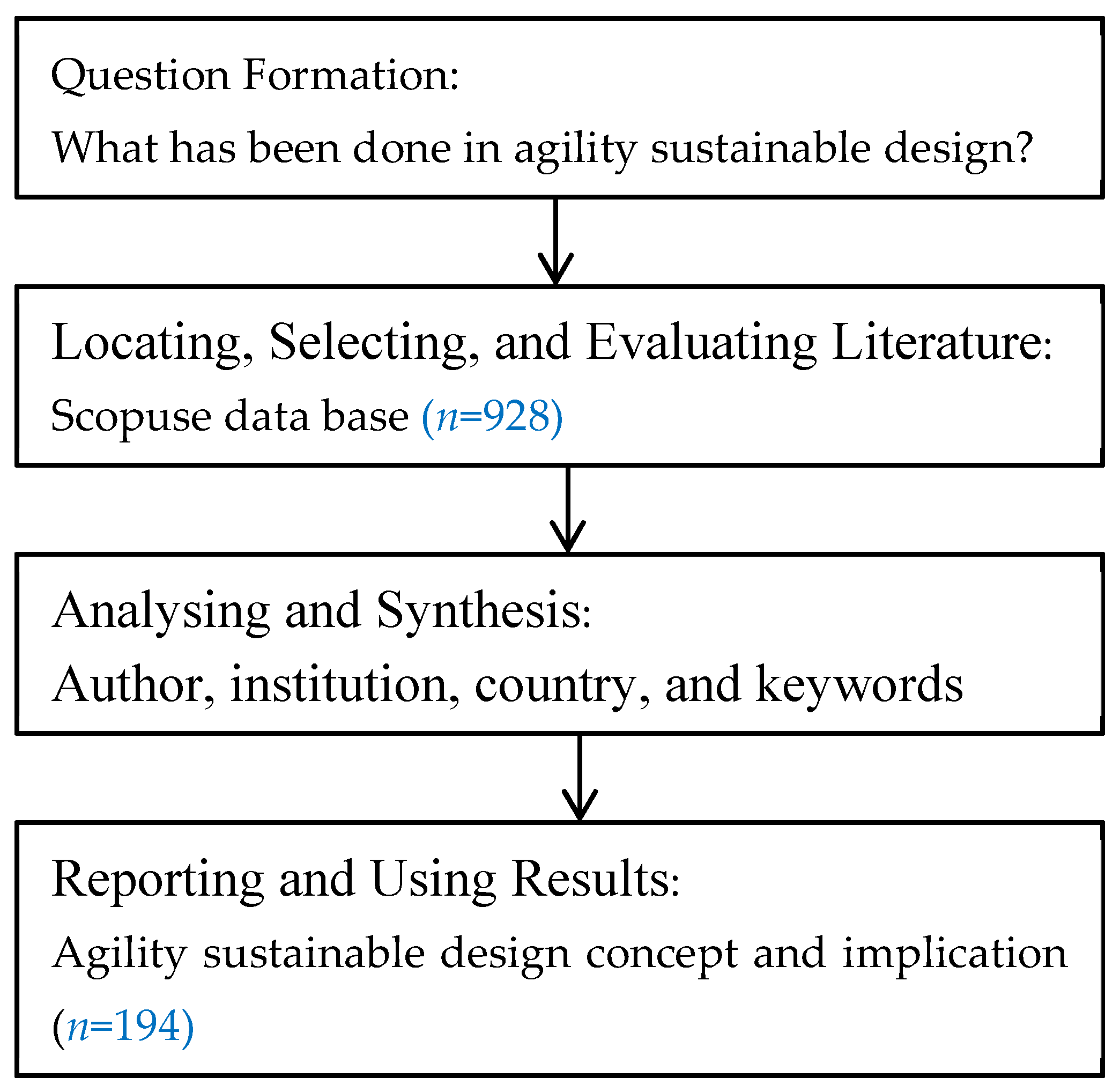
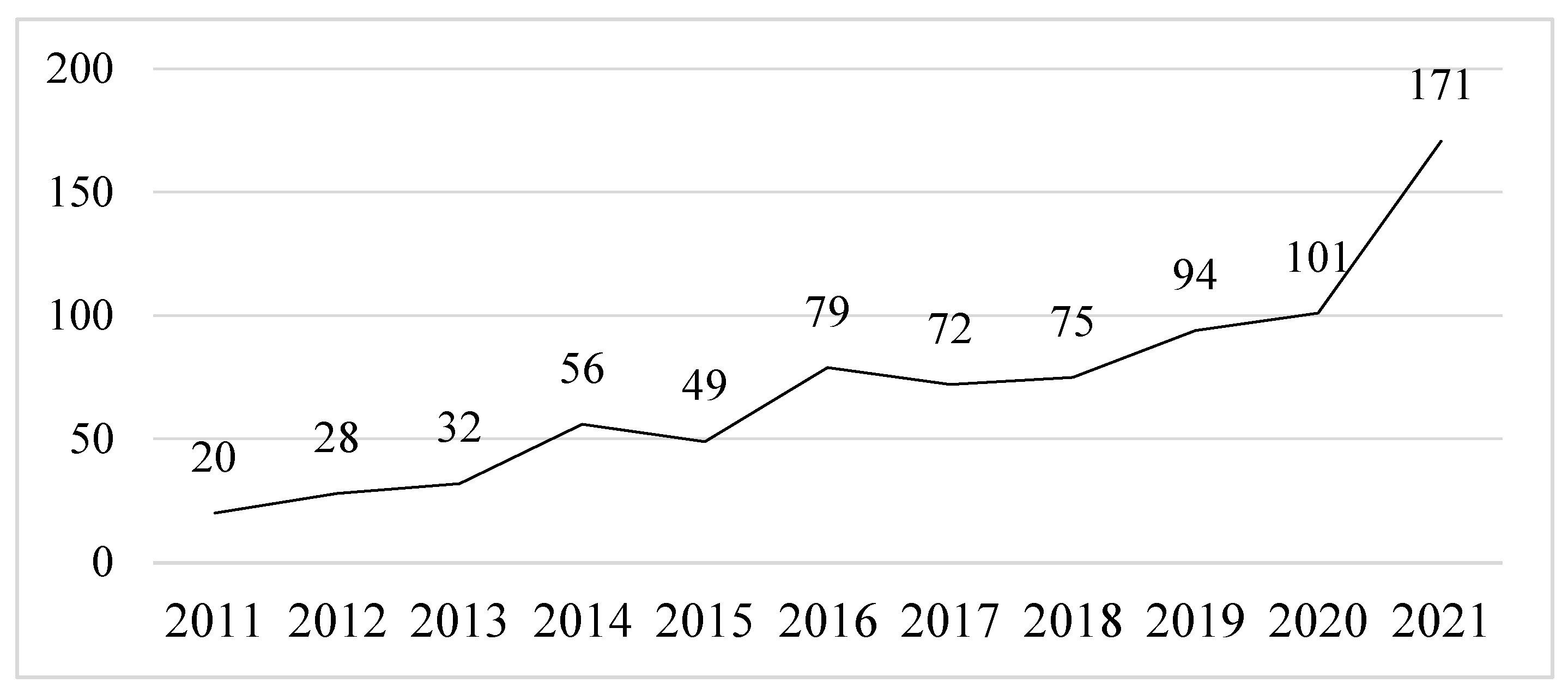
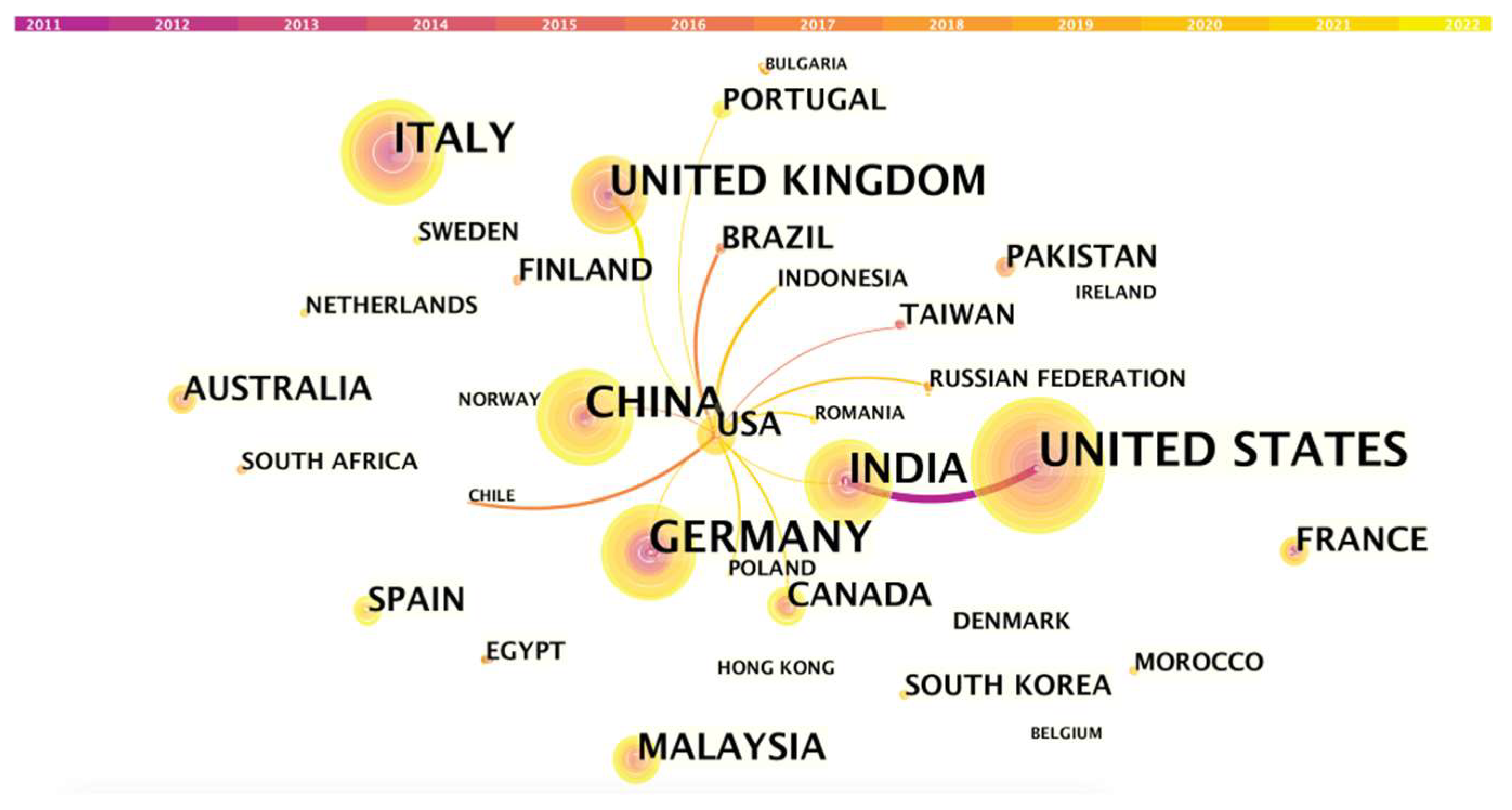


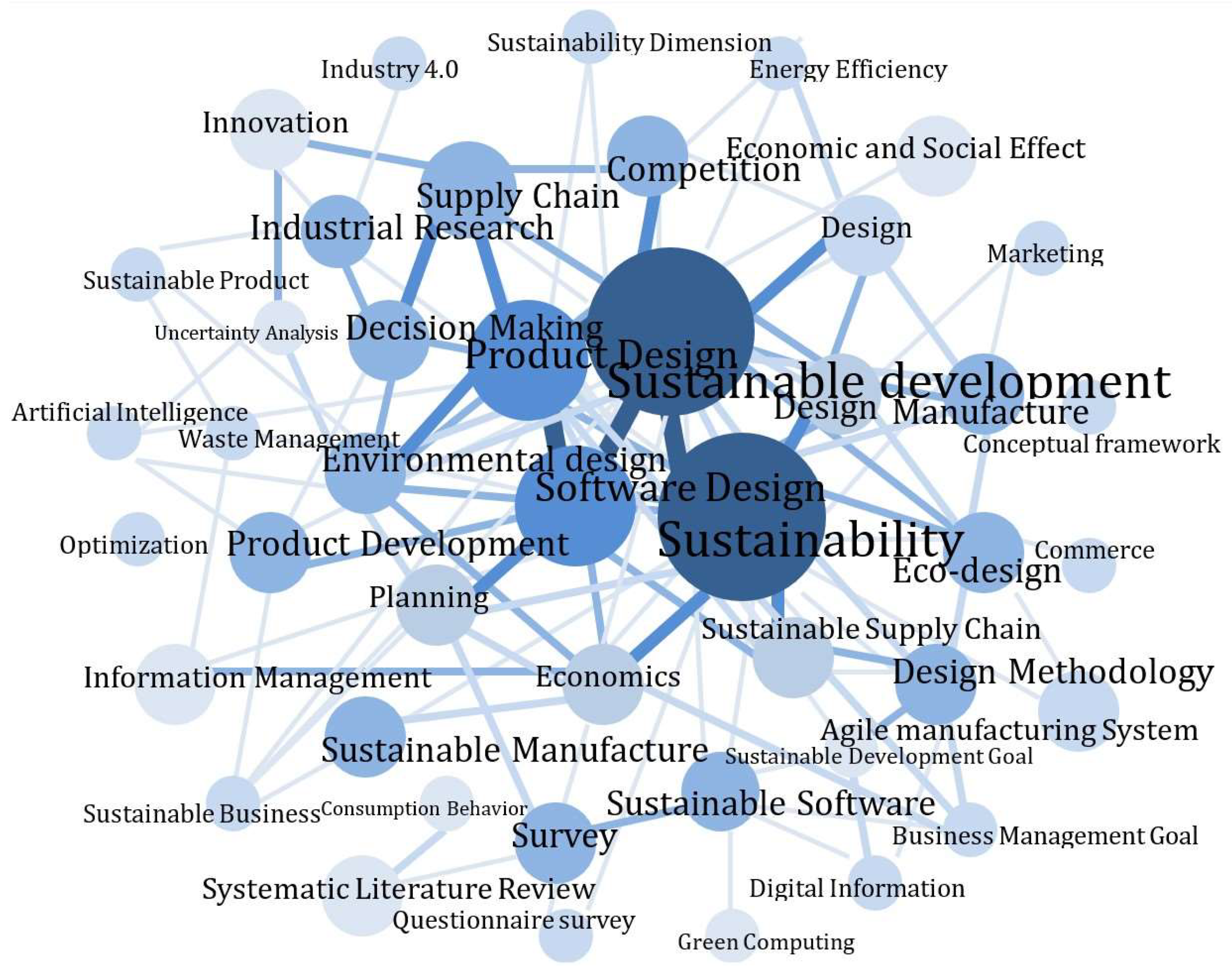
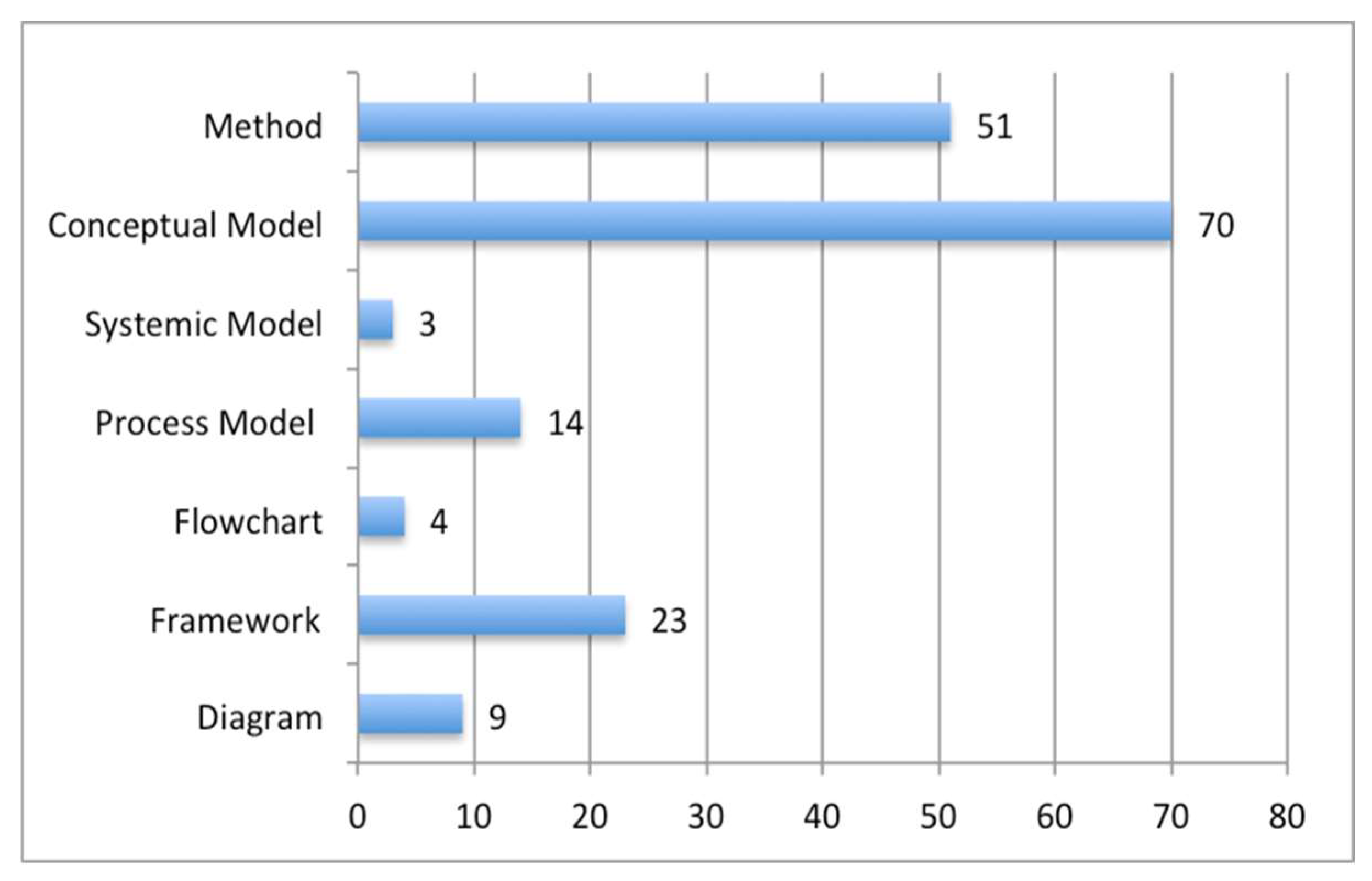
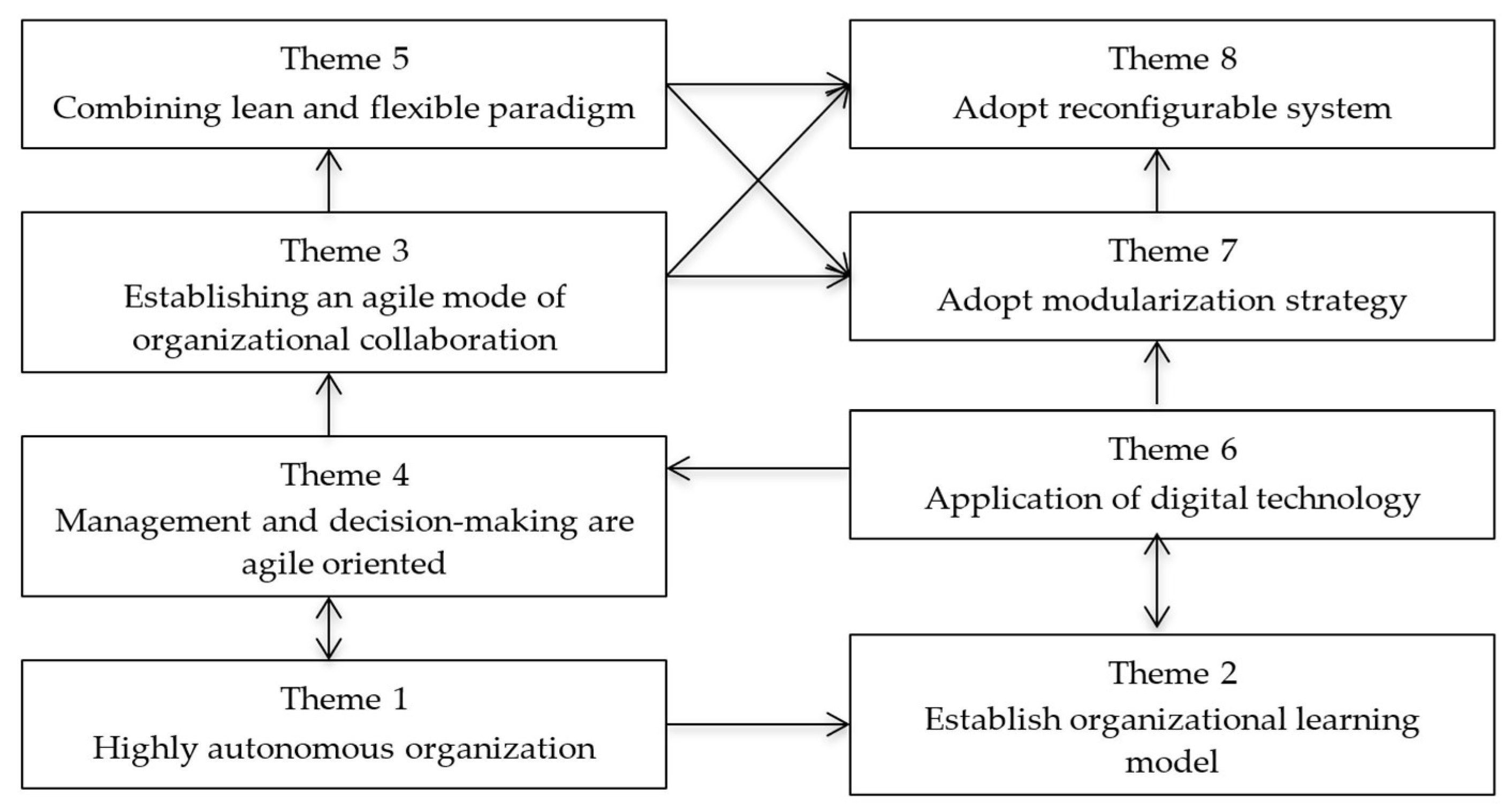
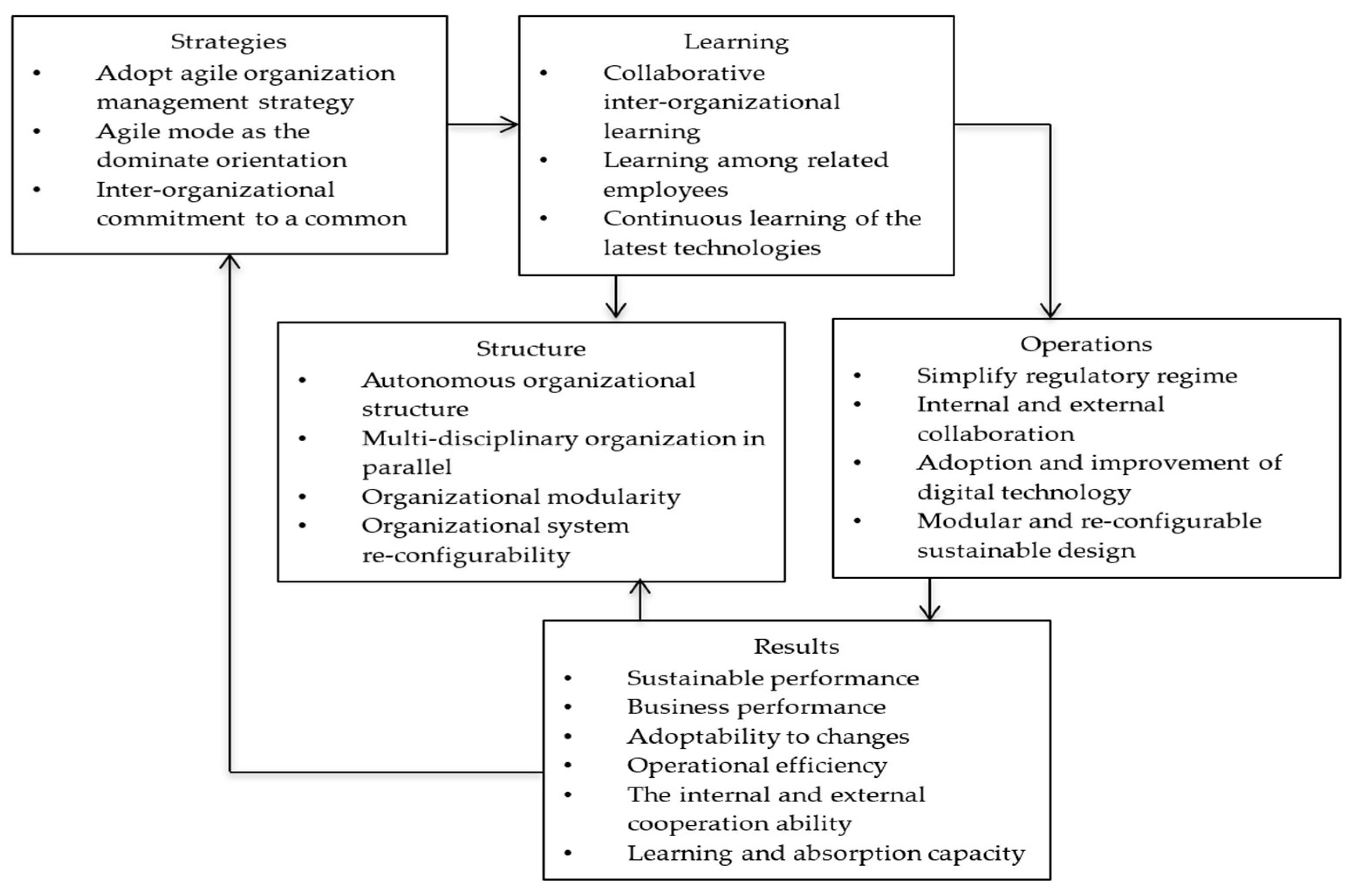
| Ranking | Journal | Counts | Percent | IF in 2021 |
|---|---|---|---|---|
| 1 | Journal Of Cleaner Production | 264 | 28% | 11.07 |
| 2 | International Journal of Production Economics | 177 | 19% | 11.25 |
| 3 | International Journal of Production Research | 173 | 19% | 9.02 |
| 4 | Sustainability | 117 | 13% | 3.89 |
| 5 | European Journal of Operational Research | 95 | 10% | 6.36 |
| 6 | Expert Systems with Applications | 85 | 9% | 8.67 |
| 7 | International Journal of Advanced Manufacturing Technology | 66 | 7% | 3.56 |
| 8 | Journal of Manufacturing Technology Management | 66 | 7% | 8.14 |
| 9 | Computers and Industrial Engineering | 65 | 7% | 7.18 |
| 10 | Omega-International Journal of Management Science | 50 | 5% | 8.67 |
Disclaimer/Publisher’s Note: The statements, opinions and data contained in all publications are solely those of the individual author(s) and contributor(s) and not of MDPI and/or the editor(s). MDPI and/or the editor(s) disclaim responsibility for any injury to people or property resulting from any ideas, methods, instructions or products referred to in the content. |
© 2023 by the authors. Licensee MDPI, Basel, Switzerland. This article is an open access article distributed under the terms and conditions of the Creative Commons Attribution (CC BY) license (https://creativecommons.org/licenses/by/4.0/).
Share and Cite
Zhao, Z.; Alli, H.; Me, R.C. A Systematic Review on the Implementation of Agility in Sustainable Design Development. Designs 2023, 7, 111. https://doi.org/10.3390/designs7050111
Zhao Z, Alli H, Me RC. A Systematic Review on the Implementation of Agility in Sustainable Design Development. Designs. 2023; 7(5):111. https://doi.org/10.3390/designs7050111
Chicago/Turabian StyleZhao, Zhining, Hassan Alli, and Rosalam Che Me. 2023. "A Systematic Review on the Implementation of Agility in Sustainable Design Development" Designs 7, no. 5: 111. https://doi.org/10.3390/designs7050111
APA StyleZhao, Z., Alli, H., & Me, R. C. (2023). A Systematic Review on the Implementation of Agility in Sustainable Design Development. Designs, 7(5), 111. https://doi.org/10.3390/designs7050111





